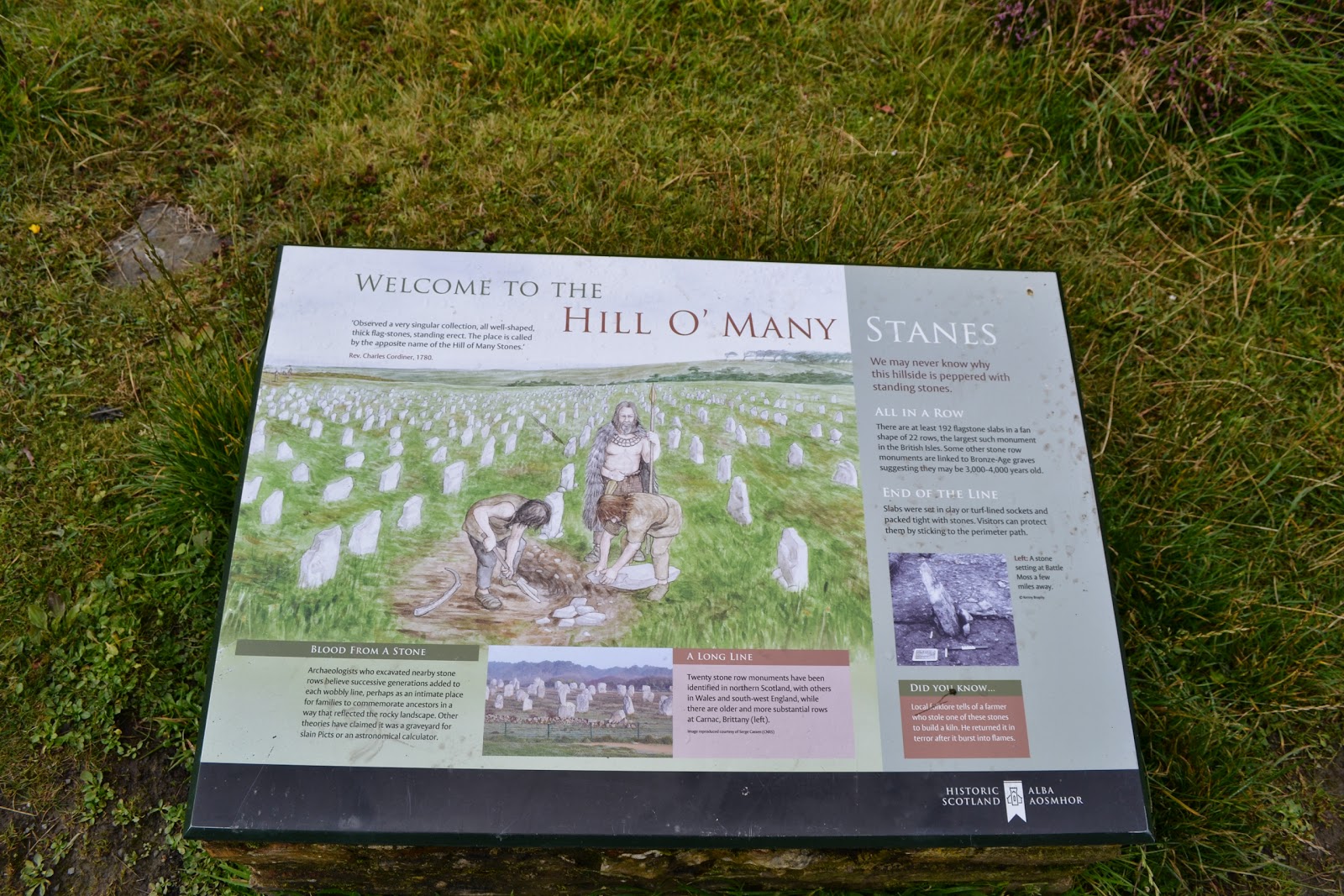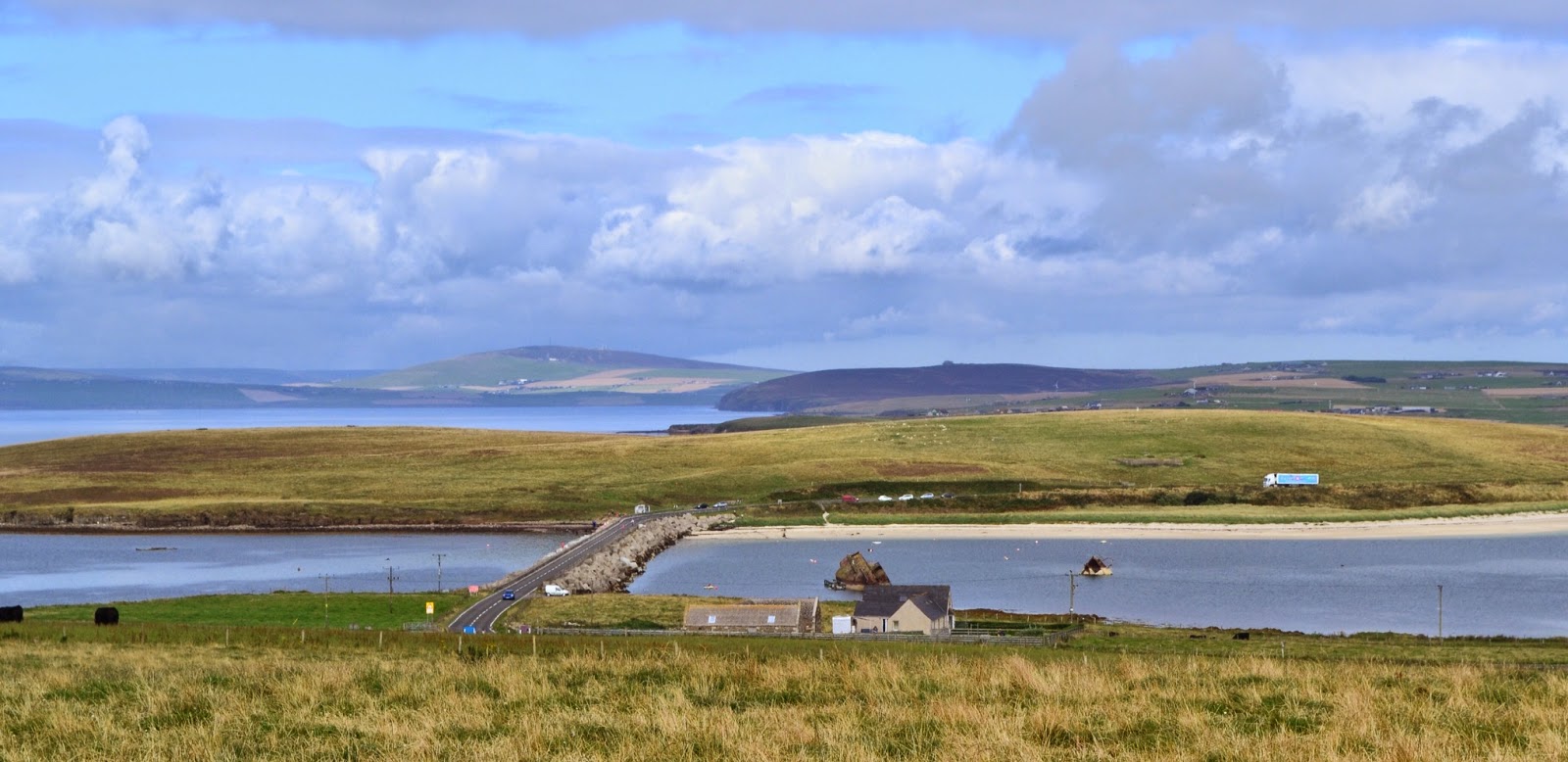 |
| Sunday we traveled to Orkney Islands, 6 miles north of tip of Scotland, reachable by ferry (or airplane.) We chose ferry from John O'Groats. Hired tour guide Kinlay of Orkney Uncovered to show us Orkney in 6 hours. Arrived south tip of Orkney in Burwick. Highlights are Scapa Flow and Churchill Barriers (home of British Naval Fleet in WWI and WWII). Skara Brae (5,000 year old Neolithic Village of 10 families discovered in 1850.) Italian Chapel (built by WWII Italian prisoners) and Ring of Brodgar (27 of 100 standing stones 4,800 years old, in 300 foot circle... older than Stonehenge!) Orkney is a neat collection of foodies who love living with vistas and history. It has the second highest per capita income in Scotland. Warmer than Dornoch (Gulf Stream.) I can see why people choose it as their home. I am sold. National Geographic article on Skara Brae, the reason we traveled to Orkney. On the way, we zipped into a place I have wanted to zip into for 15 years, the Hill o Many Stanes. Neolithic site (5,000 years ago) in NE Scotland, a sixth of original left. What was it? Many guesses. Most likely stones marking families. Gorgeous 360 views over North Sea and grazing lands. Then up to John O'Groats to catch passenger ferry to Burwick. Approaching Orkney Islands. Old but working farmhouse overlooking Scapa Flow. Scots have TONS of words for bodies of water. Scapa Flow is the body of water open to the Atlantic on west, North Sea on NE, but surrounded by about 8 small Orcadian (which means 'of Orkney) islands. Only 100 meters deep, and sandy bottom. The world's second largest natural harbor (after Sydney), so it was used by fierce maurauding boaty Vikings from 900's on, and most recently by the British Navy... housed their entire fleet in WWI and WWII. Scapa Flow - Churchill Barriers The first photo below is a Churchill Barrier. I think. It is the bridge, which wasn't there at all at the start of WWII. A German entered Scapa Flow via these waterways between islands, in one of their infamous U-Boat submarines. Sunk a British battleship which they thought safe in this huge harbor. So first the British scuttled a few of their own ships to block the passageways. You see two of those below. The U-Boats snuck in anyway, so they had their Italian prisoners-of-war from North African campaign build 4 Churchill Barriers - huge concrete blocks piled up as a solid dam between islands. They built roads over these Barriers. Prior to this, those 3 islands were approachable only by boat. Italian Chapel A testament to the indominatable spirit living inside each of us. Front the front, a really eye pleasing little chapel placed on a peaceful hillside. From the rear, you see it is really a long Quanset Hut with brick front entrance. The adorable white and red entrance you see above was built last, and finished three months before the end of the war. Built by WWII Italian prisoners of war, who were here to build the Churchill Barriers. Look what they did inside. Remembering the beauty and elegance of chapels in Italy, they created what they could here in foreign Orkney. This chapel is made of materials they found up here in Orkney. The hanging lamps are from tin cans. The metal railings are scrap metal from ships. There is no stone relief inside on floor or wall. It is all painted. Main artist was from Moena Italy. This heart inserted in the floor (that's a flat painted concrete floor) is to profess his love for a local Orcadian lass. How they created the sanctuary of home for themselves. Even in person, this looks like real marble walls, carved columns and reliefs. It is breath taking. You really believe you are standing inside a chapel in the hills of Tuscany. Smell the rosemary?
My dear beloved friends, you know how much joy it gives me to post this photo.
|
Unfortunately my sheepy friend wasn't as interested in posing as I was in photographing.
So we walk off also.
During the drive, we asked Kinlay about the upcoming Scottish Separation Referendum. He mentioned that one of the side's speaker was "about as useful as a chocolate teapot." It took me a minute, then I got it. HA!
Now about a thirty minute drive to Skara Brae. Neolithic. From 3000 BC. That's 5,000 years ago.
Older than Stonehenge. Older than the Giza Pyramids. Roman Colliseum.
We are back in the Stone Age.
Before Bronze, Iron, Steel.
First to the Skaill House property. Skaill is Norse/ Viking talk for Skull. Which is also what they say for their toast (cheers!) because the Viking maurauders would kill their enemy, clean out the skull, pour in their liquor, and raise a toast or a "Skaill." Lovely.
In the 1850's a blast of a storm unearths some stone buildings at Skaill House's shoreline. Found out it was a Neolithic Village, 5000 years old, of 10 stone homes all connected.
Temporary stone stacks all along beach. Can anybody say Andy Goldsworthy? (We were just at Storm King in NY in July.)
Our tour guide Kinlay grew up in Orkney. He remembers playing hide and go seek amongst these houses, as it was only made into a National Historic Trust Site in 1995.
Can you picture sitting on one of these stones, fire lit, smoky and warm, talking with your family member... what working hunting that day, do we need more animal skins, who will get the fresh water for dinner.
As you stand here, you start to see people down there, see the tools and items of their daily life, smell the hearth and the food cooking, hear them talking. People are people.
Here below you can see another of the homes. In the center is the hearth. The roof would have been animal skins stretched over whalebone or wood, covered with turf. On the right wall is a set of stone shelves for storage. on the left wall is a bed, which would have used heather and animal skins for linens. The square box in front of shelves is a bait box, where they kept live bait.
All this is not rennovation. This is the real 5,000 year old stuff.
They had a sewer drain from the homes into the ocean. This was 5,000 years ago!
In the coffee bar, this poem is mounted on the back wall. It portrays Skara Brae life, along with your imagination and the photos. Early 20th century poet. Reading this after seeing the ruins of homes brought the people alive to me. Thank you to whoever placed this.
Orkney Fudge cupcake, Fudge tray bake bar, and a brownie. Keeping us tourists going.
So why keep antiquities?
So we can learn and remember.
We are just a grain of sand on the beach of eternity.
What is really neat is that
each one of us is
a precious
grain of sand.
Now to the Ring of Brodgar. It is a henge (circular ditch) surrounding a circle of stones. From about 2400 BC.
Slightly smalled than Stonehenge (Brodgar is 300 feet diameter, Stonehenge is 350 feet). Erected about the same time. You see it on the hilltop from the carpark as you approach.
Up we walk. 27 of the original 192 stones are remaining. So when they were standing, this was a ring of stones with 2 to 8 inch breaks between each stone and two entrances, north and south.
You easily see the henge here. Those two (yes he is in a kilt) are looking west out towards the Atlantic.
Does Easter Island come to mind?
No one knows what the true reason for these stones was. Kinlay's thought was defence. The location, no central altar, they were a solid wall of stones. Defence from the Vikings, the Picts, the anybody.
Standing up here, you feel the vistas. You feel the expanse of space. The sky is a slowly changing 360 panoramic backdrop. The feeling is openness, the intersection of earth and sky.
You could feel really insecure and minute.
Or you could feel expansive, connected and on top of the world.
Your choice.
So, Vikings were wild and crazy warriors. They would paint themselves bright colors, run screaming at the enemy swords drawn. They were 'beserkers', hence our word 'beserk.' Christians hired them to fight in the Crusades as mercenaries. Upon return, these Vikings would carve their name and a cross into stone to mark their victories.
Here's Beserker Bjorn's Runic writing of "Bjorn +", from 1000's. This stone was lying flat, writing side down, and just upended recently to show writing.
Running short on time. Stopped at 1200's St. Magnus' Cathedral. Inside, iron rings for British soldiers to tie up horses for safety, red sandstone pillars.
And gravestones.
Many end with "Memento Mori"... Latin for "Remember Death"... as the final words from those gone, to us here still living.
Remember to live!
Wonderful day. Time does seem so fleeting when you think back 5,000 years.
What remains? Only those things we cannot see...
Orkney's flag
And the Scottish flag.





















































Superb blog!! You have an amazing memory and your photos of Orkney are great. They help tell the real Orkney story.
ReplyDeleteIt was our pleasure to take you both on tour. Thank you for booking with Orkney Uncovered and for the brilliant review on TripAdvisor.
Kind regards,
Kinlay and Kirsty
Orkney Uncovered